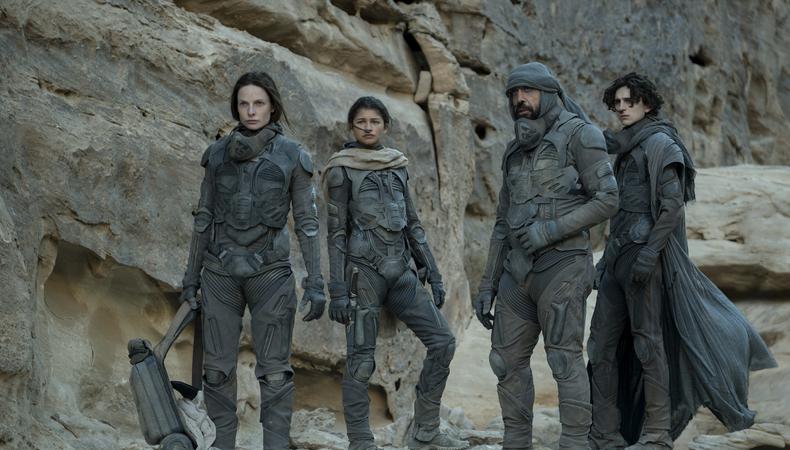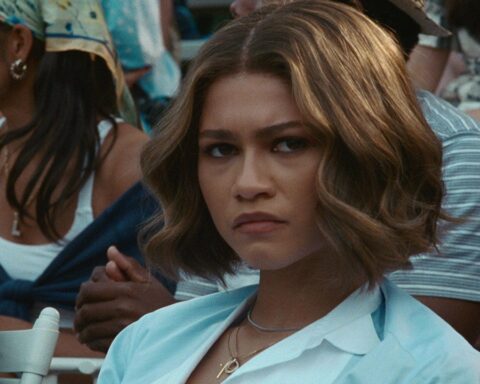From uncertainties about the saga’s eventual success – which in retrospect makes us all wonder how studio executives thought this could ever flop at the box office – to the numerous changes in its release date, Dune: Part Two took its time to reach audiences all over the world… but here we are, with one of the most anticipated sequels of the century finally landing on the big screens. As an avid fan of sci-fi/fantasy epics, of Denis Villeneuve – my favorite contemporary filmmaker – and, of course, his first film from 2021, my expectations could not have been set any higher.
Dune: Part Two continues the story of Paul Atreides (Timothée Chalamet) who now joins forces with Chani (Zendaya) and the Fremen to avenge the conspiracy that destroyed his family. Faced with a choice between love and the fate of the universe, Paul must fight to avoid the terrible future only he can foresee. Villeneuve brings back Jon Spaihts to help with the script that adapts the rest of Frank Herbert’s first book. With a cast filled with stars from the prior movie and ‘new faces’, as well as the same heads of various technical departments who have racked up award after award in Dune: Part One‘s year of release, all the ingredients for this sequel to become one of the biggest and best films of the year – and perhaps beyond that – were all in place.
Villeneuve is one of the few filmmakers in the history of cinema without a single ‘misstep’ in his filmography. In fact, the vast majority of his movies are considered by many to be some of the best that the respective genres can offer. And Dune: Part Two enters that tremendous list of unforgettable films that will define this generation and the next. In terms of cultural, commercial, and industrial impact, comparisons with Empire Strikes Back, The Lord of the Rings: The Two Towers, and The Dark Knight will be more than justified, as we are faced with the new exemplary reference of the sci-fi genre and blockbuster cinema.
I often argue that the term ‘masterpiece’ is thrown around too lightly these days, especially since we live in the Clickbait Era, where anything that can be done to garner more views is executed without any moral or ethical concerns. That said, Dune: Part Two practically demands the use of the term to describe its technical components. It’s not possible to not start with the astonishing beauty of this immersive audiovisual world. All the responsible people for their respective filmmaking sections either deliver their best work yet or one of the most remarkably memorable of their vast careers. Something that might not mean much if I were talking about random people, but the truth is, these are some of the most renowned names in the industry.

Greig Fraser further cements his position as one of the best cinematographers of today. From the distinct color palettes associated with each world and Great House to the exceptional handling of action sequences, it’s the massive scale of Dune: Part Two that separates it from any other movie within the genre. We’ve all watched blockbusters of grand scope in the past, but Fraser and Villeneuve surpass what was thought to be the limit of the genre and cinema itself. Whether it’s turning characters into mere ants with absolutely stunning wide shots or the impressive use of empty space – never has so much been seen beyond what’s in front of the screen – it’s a job that must deliver Fraser his first-ever (!) Oscar.
But if Fraser is still looking for his year of ceremonial congratulations, Hans Zimmer has lost count of the numerous scores that have become unforgettable classics of the seventh art. After all, we’re talking about the composer behind the music of Gladiator, The Lion King, The Dark Knight, Pirates of the Caribbean, Inception, Interstellar, Dunkirk, Blade Runner 2049, Dune: Part One, among many other works distinguished by his unique melodies and symphonies. Thus, there’s no better way to describe what I felt when experiencing the score of Dune: Part Two than simply stating it’s as chill-inducing, overwhelmingly emotional, and truly glorious as any of the aforementioned in this paragraph. I don’t usually remain seated in the theater until the final credits roll completely, but not only did I do so this time, but I also kept feeling the tightness in my chest and the humid eyes that accompanied the film itself.
However, the pillars of any movie are the story and characters. As mesmerizing and mind-blowing as the technical aspects are, without genuine interest in these two elements, Dune: Part Two would fail, and fail hard. For those who exclusively expect a show of action, visual effects, explosions, and endless wars, I recommend tempering such unrealistic expectations. Just like The Two Towers, the first two acts of the film focus on establishing and developing relationships, using plot points to generate tension and anticipation, and building up emotions so that the conclusion, indeed inducing audiovisual astonishment, has the most impact it can possibly have.
Dune: Part One focuses more on the political game and power struggle between the Harkonnen and Atreides houses, as well as the involvement of the natives of Arrakis (Fremen) and the Emperor’s plans (Christopher Walken), despite him appearing only in the sequel. It’s a slower movie with more exposition and the necessity to construct the foundations of this fictional universe, addressing discussion topics more related to the economy, climate, and natural resources of the planet than to intimate relationships between characters or communities.

Dune: Part Two continues to explore that political layer – more through the brutality and violence of war – but clearly with a greater focus on its characters. The first act is, for all intents and purposes, a romance. Villeneuve and Spaihts devote practically the entire first hour to exploring the central relationship of the narrative. As Paul gets to know the culture of the Fremen and learns their desert survival techniques, his connection with Chani grows in a natural, tremendously compelling manner, culminating in one of the most paradisiacal first kisses I’ve ever seen on the big screen.
The sequel’s screenplay continues to carry the thematic weight characteristic of Herbert’s novel. From colonialism and freedom, love and destiny, religion and faith, Dune: Part Two manages to deliver a global study of all these themes and blend them with terrific narrative efficiency. It deconstructs formulaic ideas behind concepts like the prophesizing of a messiah, creating uncertainty about a future dependent on a community divided by faith – or lack thereof – in a “chosen hero”. It also delves into the mythology and spirituality connected with its protagonist, examining the impact of a religious community that believes and decides its fate based on something inexplicable rather than individual choice or merit. It’s a timeless meditation on the human condition, power dynamics, and our relationship with the natural world.
Dune: Part Two introduces new characters like Princess Irulan (Florence Pugh), Lady Margot Fenring (Léa Seydoux), and the Emperor himself. But no one stands out as much as Feyd-Rautha Harkonnen, a true psychopath portrayed in an extremely menacing manner by Austin Butler. The second act has several sequences where his demonic presence is frighteningly captivating, and his appearance somewhat resembles Freeza (Dragon Ball), making his scenes viscerally violent even more special. The coldness and inhumanity that characterize him originate ruthless moments that will leave any viewer in awe.
Yet, here I arrive at the only minor issue I have with Dune: Part Two for now. I state “for now” because the truth is that we’re missing the third film to complete this saga and, as we well know, opinions change over time, but also with the complete overarching story. Some characters in this sequel have little to no impact on the main storyline or protagonist’s journey but hold considerable minutes of screen time. Inevitably, the importance of these characters and their actions can only be attested at the end of the trilogy, making it difficult to form a final opinion on a problem that may, in fact, not be a problem at all.
It’s a detail that doesn’t hurt the adoration I have for Dune: Part Two, nor the total satisfaction with the third act that everyone desires to experience on the largest screen possible. It’s one of the greatest audiovisual spectacles of the century, and no, that’s not an exaggeration. The movie’s budget was 190 million dollars, which questions the dubious technical quality of other films with the same or higher financial capacity. Throughout my cinephilic life, genuinely cathartic, “chills all over my body” moments caused by a majestically epic conclusion of titanic scale were quite rare.

Personally, I only realize I’m experiencing one of those moments when I notice, later than I should, that I find myself with a smile from ear to ear and my mouth open as if I were witnessing something never seen before. The final battle compensates for any minor issues with Dune: Part Two. It’s the flawless culmination of an exciting story from start to finish, where despite a runtime of almost three hours, it’s brilliantly paced – the exquisite editing by Joe Walker helps immensely. The versatility of the action is the main highlight: whether it’s beams from spaceships, atomic bombs, duels, or beautifully choreographed fights with and without knives/swords… there’s a bit of everything for all tastes.
Army charges are, for me, the most exhilarating type of war sequence there is. These put me in an unexplainable, purifying state of mind and soul. Dune: Part Two manages to recreate this sort of set piece, and even goes beyond that. With the evolution of technology and filmmaking in general, the charges no longer end with quick, choppy cuts, but with long, uninterrupted takes of stupendous, riveting fighting. Again, the absurdly huge scale is noticeable even in the number of characters present on the screen in a medium shot.
A common criticism of The Two Towers is that more than half of the film is merely set up for the climactic battle. I anticipate the same type of criticism for Dune: Part Two, but the defense against such an argument remains the same. The substantial narrative and thematic depth contribute to the overarching story, as well as the development of characters with the introduction of new relationships, impactful revelations, and changes in personal motivations. The versions of Paul, Chani, and Lady Jessica who begin the movie aren’t the same by the end of it, just as the emotional connection to these characters, the gradually richer world-building, and the enveloping narrative complexity.
For all this, and I’ll conclude with this paragraph, the cast is crucial. Dune: Part Two owes a lot to the actors and actresses who deliver some of the best performances of their respective careers. There are no more doubts about Chalamet’s potential. His transformative portrayal of Paul is the best I’ve seen from him in his short career. His chemistry with Zendaya is as authentic as one could ask for, with the actress often stealing the spotlight when she appears on screen. Rebecca Ferguson also makes Lady Jessica an even more mysterious character than she already was, and Pugh, Seydoux, and Walken make the most of their limited screen time to shine nonetheless. Josh Brolin, Dave Bautista, Stellan Skarsgård, Javier Bardem… I feel the need to mention all of them because all these performances deserve recognition. It would be impossible to ask for a better cast. It would be impossible to ask for a better film.
Dune: Part Two surpasses even the highest expectations, establishing itself as an unquestionable technical masterpiece of blockbuster filmmaking. With a narrative that deepens the complex web of political relationships, power, faith, love, and destiny, it not only provides a breathtaking audiovisual spectacle, thanks to the genius of Denis Villeneuve, Greig Fraser, and Hans Zimmer, but it also offers a profound meditation on universal human themes through thematically rich world-building and thoroughly developed characters. The superb performances of the entire cast, led by a career-best Timothée Chalamet and a mesmerizing Zendaya, further elevate this incredibly immersive cinematic experience. It warrants comparisons with the greatest sequels in history, easily becoming the new generational epitome of sci-fi epics.






